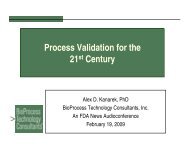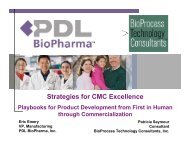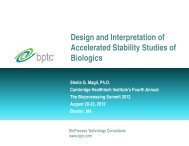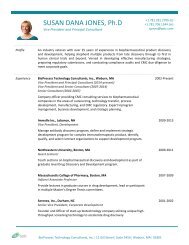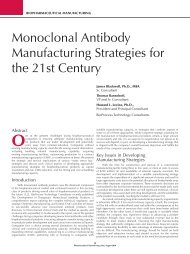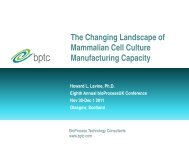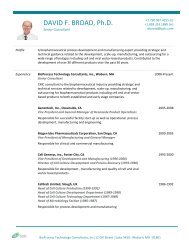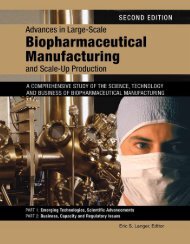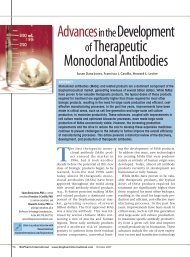Applying quality by design to vaccine development - BioProcess ...
Applying quality by design to vaccine development - BioProcess ...
Applying quality by design to vaccine development - BioProcess ...
- No tags were found...
You also want an ePaper? Increase the reach of your titles
YUMPU automatically turns print PDFs into web optimized ePapers that Google loves.
Application of Quality <strong>by</strong>Design <strong>to</strong> Vaccine DevelopmentCambridge Healthtech Institute’s Seventh AnnualThe Immunotherapeutics and Vaccine SummitAugust 13-16, 2012Cambridge, MASheila G. Magil, Ph.D.<strong>BioProcess</strong> Technology Consultantswww.bptc.com
Presentation Outline‣ What is QbD, briefly• Overview― His<strong>to</strong>ry― Goals• Advantages and Disadvantages‣ Why apply QbD principles <strong>to</strong> <strong>vaccine</strong> <strong>development</strong>• Vaccines are not monoclonal antibodies• QbD application at each <strong>development</strong> stage‣ Example2 From Clone <strong>to</strong> Clinic®
ICH QbD Guidance‣ Q8 Pharmaceutical Development‣ http://www.ich.org/fileadmin/Public_Web_Site/ICH_Products/Guidelines/Quality/Q8_R1/Step4/Q8_R2_Guideline.pdf‣ Q9 Quality Risk Management‣ http://www.ich.org/fileadmin/Public_Web_Site/ICH_Products/Guidelines/Quality/Q9/Step4/Q9_Guideline.pdf‣ Q10 Pharmaceutical Quality System‣ http://www.ich.org/fileadmin/Public_Web_Site/ICH_Products/Guidelines/Quality/Q10/Step4/Q10_Guideline.pdf‣ Q11 Development and Manufacture of Drug Substances‣ http://www.ich.org/fileadmin/Public_Web_Site/ICH_Products/Guidelines/Quality/Q11/Step_2/Q11_Step_2.pdf4 From Clone <strong>to</strong> Clinic®
Mab vs VaccinesDifferences Effecting Development StrategyMAb Vaccines ImplicationsUsually well‐characterized Often difficult <strong>to</strong> characterize Less definitive analyticalcomparabilityMore difficult <strong>to</strong> moni<strong>to</strong>rproduct <strong>quality</strong> mid‐ processClear Link <strong>to</strong> MOAMay have biomarker surrogatefor clinical performanceConsistent process andproductTherapeutic patientpopulationWell‐unders<strong>to</strong>od process gooddetectability for test methodsDifficult <strong>to</strong> establish clinicalpotency surrogateMore complex, lesspredictable process/productProphylactic patientpopulationLess unders<strong>to</strong>od process,difficult <strong>to</strong> measure attributechangesChallenges <strong>to</strong> improve processpost‐licensureVariability overproduct/process life cycle“Process is Product”philosophyEmpirical process models forlinking parameter inputs <strong>to</strong><strong>quality</strong> outputsMore stringent threshold forreporting manufacturingchanges5 From Clone <strong>to</strong> Clinic®
QbD for Vaccines‣ A‐VAX: <strong>Applying</strong> Quality <strong>by</strong> Design <strong>to</strong> Vaccines‣ http://www.pda.org/Home‐Page‐Content/CMC‐VWG‐A‐VAX.aspx‣ Produced <strong>by</strong> the CMC‐Vaccines Working Group• GSK, MedImmune, Merck, Pfizer, sanofi pasteur‣ Placed in the public domain <strong>by</strong> PDA‣ Use the A‐Vax study product and process description for general discussion ofQbD approach for <strong>development</strong> of <strong>vaccine</strong>s6 From Clone <strong>to</strong> Clinic®
What is QbD?‣ Quality <strong>by</strong> Design (QbD) is a concept first outlined <strong>by</strong> well‐known <strong>quality</strong> expertJoseph M. Juran in various publications, most notably Juran on Quality <strong>by</strong> Design.Juran believed that <strong>quality</strong> could be planned, and that most <strong>quality</strong> crises andproblems relate <strong>to</strong> the way in which <strong>quality</strong> was planned in the first place.‣ QbD identifies characteristics that are critical <strong>to</strong> <strong>quality</strong> from the perspective ofpatients, translates them in<strong>to</strong> the attributes that the drug product should possess,and establishes how the critical process parameters can be varied <strong>to</strong> consistentlyproduce a drug product with the desired characteristics.‣ Systematic process <strong>to</strong> build <strong>quality</strong> in<strong>to</strong> a product from the inception <strong>to</strong> finaloutput.‣ Quality <strong>by</strong> Design is a systematic approach <strong>to</strong> <strong>development</strong> that begins withpredefined objectives and emphasizes product and process understanding andprocess control, based on sound science and <strong>quality</strong> risk management.7 From Clone <strong>to</strong> Clinic®
What Does That Mean?‣ Systematic approach <strong>to</strong> <strong>development</strong>• Identify the cus<strong>to</strong>mer• Use <strong>to</strong>ols <strong>to</strong> prioritize activities• Iterative process building on knowledge gained‣ Predefined objectives• CQAs• QTPPs‣ Emphasizes product and process understanding and process control• Identification of critical process parameters linked <strong>to</strong> CQAs• Prior knowledge‣ Based on sound science• First principles understanding‣ Quality risk management• Use risk assessment <strong>to</strong>ols consistently• Revise risk assessments as knowledge is gained8 From Clone <strong>to</strong> Clinic®
QbD = Enhanced Product Quality‣ The product is <strong>design</strong>ed <strong>to</strong> meet patientneeds and performance requirements‣ The process is <strong>design</strong>ed <strong>to</strong> consistently meetproduct critical <strong>quality</strong> attributes‣ The impact of starting raw materials andprocess parameters on product <strong>quality</strong> is wellunders<strong>to</strong>od‣ Critical sources of variability are identifiedand controlled through appropriate controlstrategiesDesign Space: “The multidimensional combinationand interaction of input variables (e.g., materialattributes) and process parameters that have beendemonstrated <strong>to</strong> provide assurance of <strong>quality</strong>”Ref: AS Rathore & H. Winkle, Nature Biotech 2009H. Winkle, BPI Conference 2010From Clone <strong>to</strong> Clinic®
QbD Based on Scientific & Risk Based ApproachRef: D. Low, BPI Conference 2010From Clone <strong>to</strong> Clinic®
Critical Quality Attributes“…those physical, chemical, biological, or microbiological properties or characteristicsthat should be within an appropriate limit, range, or distribution <strong>to</strong> ensure the desiredproduct <strong>quality</strong>…” ‐ ICH Q8Risk (Criticality) α Impact x UncertaintyRisk that an attribute impactssafety or efficacyImpact attribute has on safetyor efficacy. Determined <strong>by</strong>available knowledgeUncertainty in assigning impact– determined <strong>by</strong> relevance ofknowledgeManufacturabilityStability Immunogenicity= Safety ?11From Clone <strong>to</strong> Clinic®
What are Critical Process Parameters (CPPs)‣ Independent process parametersmost likely <strong>to</strong> affect CQAs, including• Purity• Qualitative and quantitativeimpurities• Physical characteristics• Microbial <strong>quality</strong>‣ Determined <strong>by</strong> sound scientificjudgment and based on research,scale‐up or manufacturing experience‣ Controlled and moni<strong>to</strong>red <strong>to</strong> maintainCQAs12From Clone <strong>to</strong> Clinic®
Critical Process Parameters Drive Critical Quality AttributesRange of Raw MaterialAndFacility AttributesProcess Designed <strong>to</strong>Limit Product Variability‣ Define Drug Substance in terms of CQAs‣ Identify CPP that affect these CQAs‣ Determine range of each CPP that produces acceptableproduct <strong>to</strong> establish the Design Space
Knowledge SpaceRef: B. Davis, FIP Conference 2007
Design Space‣ Design space is proposed <strong>by</strong> the applicant and is subject <strong>to</strong> regula<strong>to</strong>ry assessmentand approval• Any process that runs within previously defined and approved <strong>design</strong> space isnot considered a change• Operation outside of previously approved <strong>design</strong> space requires a regula<strong>to</strong>rypost‐approval change processRepeat UnitsYieldRM 1RM1From Clone <strong>to</strong> Clinic®
Creating a Design Space: Putting it All Together‣ Summarize results ofmultiple experiments <strong>to</strong>define response surface‣ Validate the process <strong>to</strong>demonstrate consistentproduction of productwith desiredcharacteristics% LysisFeed RateDesign SpaceRaw Material 1RepeateUnitsFrom Clone <strong>to</strong> Clinic®
Downstream Design Space:Ion Exchange Column Load Conditions‣ Purification of Ps <strong>by</strong> anion exchange chroma<strong>to</strong>graphy‣ Column equilibrated with 10 mM TRIS‐Phosphate buffer‣ Variation of load solution pH will impact product yield and purityProduct peak(s)From Clone <strong>to</strong> Clinic®
Design Space: Anion Exchange Column Yield and Purity‣ Best yield at pH 7.0‣ However, additionalcontaminant present inpool that is not seen athigher pHProductContaminant‣ Can subsequentprocess steps removethis contaminant?From Clone <strong>to</strong> Clinic®
Overall Design Space: Final Product PuritySubsequent process step removes process contaminantregardless of pH at which Anion Exchange column is runA –Anion exchange column pool, pH 7.0B–Anion exchange column pool, pH 8.6C–Column 2 pool following loading with “A”D –Column 2 pool following loading with “B”From Clone <strong>to</strong> Clinic®
QbD Work Flow for Development of a VaccinePotential CQAsInterim CQAsFinal CQAControl StrategyPlatform KnowledgeTox Study RangesNon‐clinical studiesDose rangingProcessValidationFew Tests andNarrow AcceptanceRangesMultiple Tests withWide Acceptance RangesBLA SubmissionPhase 1 Phase 2 Phase 3 Commercial21 From Clone <strong>to</strong> Clinic®
Key Planning Step: Identify the Cus<strong>to</strong>mer‣ Overall patients, physicians and Regula<strong>to</strong>rs‣ Each process step may have different cus<strong>to</strong>mers‣ Upstream cus<strong>to</strong>mer is downstream‣ Downstream cus<strong>to</strong>mer is formulation,‣ Do not forget that at each step the cus<strong>to</strong>mer is also the manufacturing, <strong>quality</strong> andregula<strong>to</strong>ry groups22 From Clone <strong>to</strong> Clinic®
Next Step: Target Product Profile (TPP) from A-VAX Case StudyParameterMechanism of ActionIndicationPrimary EndpointsKey ClaimsSecondary EndpointsFormulation/DosingApprovals andRecommendationsDescriptionA‐VAX is a pentavalent <strong>vaccine</strong>s containing the capsularpolysaccharide (Ps) of 5 serotypes, each linked <strong>to</strong> a recombinant noninfectiousvirus‐like particle (VLP) and adjuvanted with Al salt.Expected <strong>to</strong> produced enhanced cellular and humoral antigen specificprotective immunityActive immunization of 2‐60‐month old infants and children forprevention of disease related illnesses due <strong>to</strong> causative agent70% reduction of confirmed disease within 1 year after dosing in thetarget population, Safe and <strong>to</strong>lerableFavorable risk‐benefit ration, can be dosed with other pediatric<strong>vaccine</strong>s, achieves WHO stability requirementsReduction of disease specific hospitalizations and ER visits, reductionof causitive agent specific disease, duration of protection > 1 yearAntigen/Adjuvant in pre‐filled syringe or single dose vial, containerspre‐mixed prior <strong>to</strong> injection, 3 doses administered 2 months apart –preferably on standard pediatric <strong>vaccine</strong> scheduleExpecting Advisory Committee on Immunization Practices and otheruniversal recommendations23 From Clone <strong>to</strong> Clinic®
Quality Target Product ProfileParameterKey ClaimsFormulation/DosingDescriptionEasy <strong>to</strong> administer, 0.5 mL subcutaneous delivery in an outpatient settingusing a 1 mL syringe (27g x ½ inch needle)Stable 2 years at RT or 4 years at 2‐8°CStability following reconstitution:24 hours physical and chemical (2‐8°C) or 8 hours at RTNo animal or human derived material used in manufactureSterile product, DS (Ps‐VLP) can be sterile filtered3 doses (containing 5g each of 4 Ps and 50g of fifth Ps adsorbed <strong>to</strong>300g Al adjuvant) administered 2 months apartLyophilized and reconstituted with standard dilutents contaiing adjuvant,rapid reconstitution profile with suitable viscosityComposition: sugar, surfactant, buffer (iso<strong>to</strong>nic and normal pH) and Ps‐VLPLabel volume 0.5 mLPrimary packaging: Single dose vial, clear Type I glass, latex‐free s<strong>to</strong>pperand seal with flip‐off plastic but<strong>to</strong>nSecondary packaging and shipping: allowed shipping excursiontemperature 2‐40°C for 3 days (10 vials/car<strong>to</strong>n)24 From Clone <strong>to</strong> Clinic®
Control Strategy Vocabulary 1TerminologyQuality AttributeCritical Quality Attribute(CQA)Less Critical QualityAttributeAcceptance CriteriaPerformance AttributeDefinitionA physical, chemical, biological or microbiological property orcharacteristic of the product whose variability might have potentialimpact on the safety and efficacy of the product. At early stages of<strong>development</strong> some of these are liley <strong>to</strong> be “potential CQAs”A physical, chemical, biological or microbiological property orcharacteristic of the product that should be within an appropriatelimit, range or distribution <strong>to</strong> ensure the desired product <strong>quality</strong> (ICHQ8 (R2))A <strong>quality</strong> attribute determined through risk analysis <strong>to</strong> be less critical<strong>to</strong> assurance of desired product <strong>quality</strong> efficacy and safetyNumerical limits, ranges or other suitable measures for acceptancewhich the DS or DP or intermediate materials should meet <strong>to</strong>conform with the specification of the results of analytical proceduresA physical, chemical, biological or microbiological property orcharacteristic of the product whose variability might have a potentialimpact on process performance25 From Clone <strong>to</strong> Clinic®
Control Strategy Vocabulary 2TerminologyKey PerformanceAttribute (KPA)Critical ProcessParameter (CPP)Key ProcessParameter (KPP)Design SpaceFormalExperimental DesignDefinitionA parameter that when controlled ensures optimal process performanceA process parameter whose variability has an impact on a CQA andtherefore should be moni<strong>to</strong>red or controlled <strong>to</strong> ensure the processproduces the desired <strong>quality</strong>An adjustable process parameter of the process that when maintainedwithin a narrow range ensures optimum process performance. A KPPdoes not meaningfully affect CQAs. Ranges for KPPs are establishedduring process <strong>development</strong> and changes <strong>to</strong> these ranges will bemanaged within the Quality SystemThe multidimensional combination and interaction of input variables andprocess parameters that have been demonstrated <strong>to</strong> provide assuranceof <strong>quality</strong>A structured, organized method for determining the relationship betweenfac<strong>to</strong>rs affecting a process and the output of that process (DOE)26 From Clone <strong>to</strong> Clinic®
QbD for Vaccines27From Clone <strong>to</strong> Clinic®
Wide Range of Technologies Available for Vaccine ProductionToxoid(Bacterial)Live,attenuatedVirus‐likeparticleInactivated Subunit DNAKilled,Empirical Recombinant metabolically Purified RecombinantactiveVec<strong>to</strong>rConjugate(e.g., proteinpolysaccharide)From Clone <strong>to</strong> Commercial®
Example:Application of QbD <strong>to</strong> Influenza VaccinesProcesses adapt <strong>to</strong> Seasonal Strain VariationsFrom Clone <strong>to</strong> Clinic®
Influenza Virus Types‣ Influenza Type A• Infects humans, birds, pigs, horses• Most prevalent, occurs in several Sub‐Types• Most likely <strong>to</strong> demonstrate Antigenic Drift Shift• Major Antigenic Shift may lead <strong>to</strong> pandemic‣ InfluenzaType B• Infects humans, seals• Less volatile, no sub‐types• Antigenic drift, slower than Type A‣ Influenza Type C• Infects humans• Comparatively rare –not included in standard <strong>vaccine</strong>sFrom Clone <strong>to</strong> Clinic®
Diagram of Influenza VirusHemagglutinin HANeuraminidase NAFrom Clone <strong>to</strong> Clinic®
Identification of New Influenza Virus Strains‣ New ‘A’ viruses arise <strong>by</strong> recombination or re‐assortment (dual infections) inanimals, birds‣ Most often in the Far East• People living in close proximity <strong>to</strong> pigs, ducks, etc.‣ Chain of WHO Influenza Diagnostic Labora<strong>to</strong>ries• Constantly checking new isolates for antigenic “Shift” versus “Drift”‣ Requirement for change in <strong>vaccine</strong> strains when significant drift or a major shif<strong>to</strong>ccurs, MOST OFTEN IN TYPE A.‣ Notified <strong>by</strong> WHO in January ‐ March for Western World.‣ CDC, Atlanta GA issues new strains for manufacturers <strong>to</strong> use‣ These may need additional adaptation <strong>to</strong> eggs or cell cultureFrom Clone <strong>to</strong> Clinic®
A Wide Variety of Influenza A Strains ExistH1N1 H1N2H2N2H3N1 H3N2 H3N8H5N1 H5N2 H5N3 H5N8 H5N9H7N1 H7N2 H7N3 H7N7H9N2H9N7•H1N1 was the 1918 “Spanish Flu” type: 20% mortality world‐wide•H1N1 variant was the 2009 Pandemic flu•H2N2 caused the 1957 “Asian Flu”•H3N2 caused 1968 “Hong Kong Flu”•H5N1 is the type associated with “Avian Flu”
Influenza Vaccine Production: Viral PropagationRecombinant Seed Virus (New Isolate X Well‐growing strain)PrepareSubstrateInfect &IncubateRemove Cells,Purify VirusInactivate VirusEgg based…IncubateEmbryonated Eggs(1,000s needed)Cell based…Scale up cellculture from WCBInoculateAllan<strong>to</strong>ic SacInfect inBioreac<strong>to</strong>rHarvest Allan<strong>to</strong>icFluid, (10‐12ml/egg)Clarify, Ultra‐CentrifugeCentrifuge, TFF,Chroma<strong>to</strong>graphyTreat withformaldehydeSub‐unit <strong>vaccine</strong>s arethen solvent‐extractedAttenuated live <strong>vaccine</strong>streated <strong>to</strong> limitinfectivityFrom Clone <strong>to</strong> Clinic®
Recombinant Influenza VaccineIdentifyTarget StrainObtain sequence of antigeniccomponents (HA +/‐NA)GeneraterecombinantexpressionconstructGenerally requires no more than two weeksProduceRecombinantprotein or VLP onLarge ScaleHarvest, purify(protein or VLP)Fill/finish similar <strong>to</strong> standardbiopharmaceuticalsFrom Clone <strong>to</strong> Clinic®
Baculovirus Expression of Influenza Antigens• Influenza antigens can be expressed <strong>by</strong> cloning in<strong>to</strong> Baculoviruses and growing ininsect cell culture– Baculovirus has limited host range (No infection of mammalian cells)– Rapid scale‐up and production of new <strong>vaccine</strong> strains possibleIsolate Target GeneCreate RecombinantBaculovirus StrainGrow Up a Batch ofInsect CellsInfect & IncubateHarvestInfected CultureClarify HarvestOrNovavax: Purify VLPCollect CellsProtein Sciences: Extract & Purify rHAFrom Clone <strong>to</strong> Clinic®
expresSF+ Engineered for Vaccine Manufacturing‣ Cell line developed from Sf9 Cells• Selective pressure in serum‐free media withadded insulin (0.4 mM)• unique phenotypic and genotypic properties‣ Protein Sciences (Meriden, CT, USA) has developed FluBlok®using their proprietary BEVS baculovirus expression system• Contains three recombinant HA antigens― Dose of each antigen is 3X egg‐produced dose• Over 50,000 doses delivered with minimal adverseevents― Highly effective protective immunity generated• BLA filed, awaiting approvalUninfected SF+Infected SF+From Clone <strong>to</strong> Clinic®
Protein Sciences FluBlok ® ExpressionBaculovirus Expression Vec<strong>to</strong>r System (BEVS)• Engineer baculovirus with thegene of interest (e.g.Hemagglutinin)• Baculoviruses highly specific <strong>to</strong>insect cells• Powerful promoter generateshigh yield of protein of interest• Culture expression ofinsect cells in afermenter• Infect cells withengineered virus• Incubate infection for ~48 ‐72 hours• Protein forms rosettes• Purify protein <strong>to</strong> > 90%in<strong>to</strong> final product• Formulate with PBS in<strong>to</strong><strong>vaccine</strong>From Clone <strong>to</strong> Clinic®
QbD in Influenza Vaccine Case Study: Flublok ®‣ Flublok must be changed each year <strong>to</strong> produce the current strains• In 2011 the strains were the same for US as in 2010• Impact of strain changes on antigen biochemistry can be conservative orsignificant—Driven <strong>by</strong> epidemiology• Process must cope with annual potential change of input antigen whileoperating within predefined <strong>design</strong> space—SOP in place at Protein Sciences <strong>to</strong> drive process adaptation <strong>to</strong> newstrains
FluBlok ® Production – Downstream ProcessStep Method Purposeupstreamdownstreamfermentation bioreac<strong>to</strong>r rHA expressionharvest centrifugation cell recoveryextraction non‐ionic detergent rHA solubilizationclarification depth filtration Turbidity reductionIEXCation exchange (SP orCM)rHA capture, purificationHIC Phenyl sepharose rHA purificationQ membrane Mustang Q DNA removalUltrafiltration TFF Buffer exchangeFrom Clone <strong>to</strong> Clinic®
Process Steps have Differing Sensitivity <strong>to</strong> ChangesEvaluation of Risks in Process StepsupstreamdownstreamstepfermentationharvestIsotypevariability(H1, H3, B)Seasonalstrain variabilityuniversaluniversalVariableparametersextraction yes infrequent pH; [detergent]clarification yes no DF Filter typeIEXHICQ membraneTFFyes often pH; [salt]; columntype; [detergent]yes some pH; [salt];[detergent]universaluniversalFrom Clone <strong>to</strong> Clinic®
Qbd: Flexible Response and Process Consistency‣ How <strong>to</strong> respond quickly <strong>to</strong> seasonal strain changes while maintaining a stable,validated downstream production process?Seasonal strain changes:Necessitate rapid processadjustmentsProcess Validation:FDA requires process consistencyunder the FluBlok BLA.Commercial‐scale production:Requires a stable process platformProcess Development Group:requires guidance in order <strong>to</strong> workrapidlyFrom Clone <strong>to</strong> Clinic®
PSC SOP RG0006: a Framework for FluBlok ®Seasonal Strain-change Development‣ Applied <strong>to</strong> the process <strong>development</strong> for each new FluBlok component strain‣ Developed with FDA guidance <strong>to</strong> define acceptable modifications in downstreamprocess parameters within the scope of a validated process.‣ Assures FDA that:• any process changes are necessary and minimal.• process performance remains consistent season <strong>to</strong> season‣ Provides PSC Process Development group with guidance so that:• <strong>development</strong> procedures and acceptance criteria are clearly defined.• PD can work rapidly, knowing that process changes within RG0006 do notrequire regula<strong>to</strong>ry modification.‣ Process changes outside of RG0006 require regula<strong>to</strong>ry modification (ChangeControl)SOP RG0006 guides the work flow anddefines the downstream process <strong>design</strong> spaceFrom Clone <strong>to</strong> Clinic®
Process Development Under SOP RG0006‣ What does RG0006 tell the Protein Sciences Process Development group?• Organizes work flow between small‐scale and large‐scale.• Specifies scale‐down models.• Specifies conditions which may be altered.• Defines acceptance criteria for each step• Provides a small‐scale validation of process performance prior <strong>to</strong> transfer.• Specifies reporting activities for process transfer.From Clone <strong>to</strong> Clinic®
RG0006 Governs the Variable Processing StepsupstreamdownstreamProcessstepIsotypevariability(H1, H3, B)SeasonalstrainvariabilityVariableparametersModifiableunder RG0006?fermentation universal noharvest universal noextraction yes infrequent pH; [detergent] yesclarification yes noIEX yes oftenHIC yes someDepth filtertypepH; [salt];column type;[detergent]pH; [salt];[detergent]noyesyesQ membrane universal noTFF universal noOnly process steps with seasonal variabilityare modifiable under RG0006From Clone <strong>to</strong> Clinic®
Process Development under RG0006:Road Map <strong>to</strong> a New Seasonal ProcessTry the process for the previous year’sisotypic strain at small scaleWorks?Doesn ’t work?Evaluate at full scale(single cGMP run)Small‐scale <strong>development</strong>& optimizationWorksDoes not workSmall‐scale validation(limits for pH, etc.)cGMP full‐scale evaluationFinal full‐scaleSeasonal ProcessFrom Clone <strong>to</strong> Clinic®
Key Changes <strong>to</strong> H1 DSP Between 2009 & 2010‣ H1 Process modifications were successfully evaluated at small‐scale in PD prior <strong>to</strong>transfer <strong>to</strong> manufacturingProcess step H1 2009 H1 2010 RationaleExtraction 0 mM NaCl 50 mM NaCl Improved yieldIEX –wash 2 0 mM NaCl 100 mM NaCl Increased purityIEX ‐ elution 100 mM NaCl 250 mM NaCl Increased step‐yieldHIC ‐ equilibration 0 % CHAPS 0.05% CHAPS Improved purityFrom Clone <strong>to</strong> Clinic®
FluBlok Summary‣ FluBlok production requires evaluation and modification in response <strong>to</strong> seasonalinfluenza strain changes.‣ SOP RG0006 provides a PD & regula<strong>to</strong>ry framework for adaptation within avalidated process.‣ RG0006 provides multiple routes <strong>to</strong> <strong>development</strong> of a full‐scale process.‣ Process changes outside of RG0006 may be addressed through Change Control(BLA modification)FluBlok and PanBlok ® <strong>development</strong> supported <strong>by</strong>HHS contract HHS0100200900106CFrom Clone <strong>to</strong> Clinic®
QbD and Influenza Vaccine-An Existing Paradigm‣ Influenza <strong>vaccine</strong>s have always been manufactured within a <strong>design</strong> space• Annual strain changes impact egg production as much as recombinantproduction‣ Provides an operational case study for FDA review and implementation <strong>to</strong> otherproduct classes‣ Enables regula<strong>to</strong>ry flexibility and adaptation <strong>to</strong> emergency or rapid responserequirements‣ Quality <strong>by</strong> <strong>design</strong> as a regula<strong>to</strong>ry shift will, in the long run, facilitate manufacturingdecisions and product approvals for <strong>vaccine</strong>s and other productsFrom Clone <strong>to</strong> Clinic®
Product Control Through Process ControlCell lineProductConsistencyMedia and FeedsPotencyCulture TimeQbDStructureColumn LoadingIntermediate HoldTimePATStabilitySafetyFormulation BufferEfficacyFrom Clone <strong>to</strong> Clinic®
Acknowledgements‣ <strong>BioProcess</strong> Technology Consultants• Howard Levine, Ph.D.• Alex Kanarek, Ph.D.• Susan Dana Jones, Ph.D.‣ Protein Sciences• Robert Boulanger, Ph.D.• Al Price, Ph.D.• Dan Adams, Ph.D.From Clone <strong>to</strong> Clinic®
Thank You!Sheila G. Magilsmagil@bptc.com1-781-281-2710<strong>BioProcess</strong> Technology Consultants, Inc.12 Gill Street, Suite 5450Woburn, MA 01801
Follow us…www.bptc.comwww.bioprocessblog.combptcGlobalwww.linkedin.com/company/bioprocess-technology-consultants-inc.



